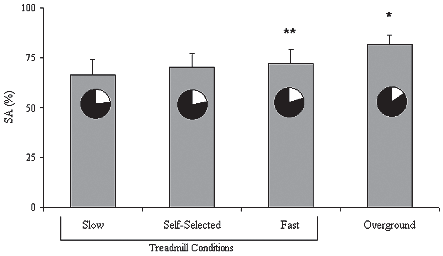|
PRACTICAL
SIGNIFICANCE
The
amount
of
impact
shock
that
children
attenuated
during
running
was
dependent
on
velocity
and
whether
or not
the
children
were
running
on a
treadmill
or
overground.
Furthermore,
the
amount
of
impact
shock
attenuated
was
different
than
expected
when
compared
to adult
data.
This
research
is a
step
towards
understanding
strategies
that can
be
implemented
to
reduce
the risk
of
running
overuse
injuries
due to
impact
forces
for
children.
STUDY
BACKGROUND
Children
have
many
opportunities
to
participate
in
sports
that
involve
running
and it
is well
documented
that
runners
are
susceptible
to
overuse
injuries.
The
impact
between
the foot
and
ground
is
likely a
factor
causing
overuse
injuries.
There
are
about
2500
collisions
between
the foot
and
ground
during a
30-minute
run.
The
magnitude
of this
impact
can be
1.5 to 3
times
body
weight.
With
each
collision,
a shock
wave of
energy
is
transmitted
throughout
the
body.
Adult
runners
absorb
approximately
80% of
the
shock
but the
amount
of shock
absorbed
by
pre-adolescent
runners
is not
known.
OBJECTIVE
Determine
the
shock
attenuation
characteristics
for
children
while
running
on a
treadmill
at
different
speeds
and
during
running
overground.
DESIGN
AND
SETTING
For the
first
experiment,
a 1
(treadmill)
x 3
(speed)
within-subjects
design
was
used,
while
for the
second
experiment
a 1
(speed)
x 2
(treadmill,
overground)
within-subjects
design
was
used.
The
study
took
place in
a
University
Biomechanics
Laboratory.
SUBJECTS
Children
(n=14;
age 10±1
yrs;
mass
38±10.1kg,
height
142.0±8.0
cm) free
from
lower
extremity
injury
participated
in this
investigation.
MEASUREMENTS
Experiment
1:
subjects
ran at
speeds
that
were 0.5
m/s
slower
(S) and
faster
(F) than
a
self-selected
(SS)
speed
for a
total of
three
speed
conditions
(S, SS,
F).
Self-selected
speed
was
determined
by
having a
subject
select a
speed
that
could be
maintained
for 15
minutes.
Experiment
2:
subjects
ran
overground
with
running
speed
matched
to SS.
One
accelerometer
was
secured
to the
anterior-medial
region
of the
distal
aspect
of right
tibia;
another
at the
frontal
region
of the
head.
Peak
impact
acceleration
was
recorded
for the
leg (LgPk)
and head
(HdPk)
acceleration
profiles.
SA was
calculated
as
[1-(HdPk/
LgPk)]*100.
RESULTS
Shock
attenuation
was
significantly
different
(P<0.05)
between
treadmill
(66.7 ±
4.8%)
and
overground
(79.4 ±
6.2%)
conditions.
LgPk was
not
different
(P>0.05)
between
treadmill
(4.2 ±
2.0 g)
and
overground
(6.2 ±
2.8 g).
HdPk was
not
different
(P<0.05)
between
treadmill
(1.4 ±
0.6 g)
and over
ground
(1.2 ±
0.6 g)
conditions.
There
was no
difference
in the
running
speeds
used per
condition
(Treadmill:
2.6 ±
0.4 m/s;
Overground:
2.6 ±
0.4 m/s,
P>0.05).
The
Actual
and
Expected
shock
attenuation
magnitudes
were not
different
for
treadmill
running
(Actual
= 66.7 ±
4.8%,
Expected:
68.7 ±
1.8%;
P>0.05)
but were
different
for
overground
running
(Actual
= 79.4
6.2,
Expected:
68.7
1.8%;
P<0.05).
CONCLUSIONS
Shock
attenuation
in
children
is
dynamic
and
dependent
on the
impact
shock,
which
varies
with
running
speed
and
surface
changes.
|
Shock Attenuation

|
Figure 1: Illustration of Shock Attenuation (SA) during different running conditions. The embedded pie chart illustrates the proportions of leg (black) and head (white) impact accelerations. Note: *: SA different during Overground and Treadmill Self-Selected speed (P<0.05). **: SA different across running speeds (P<0.05). |
Funded
by NFL
Charities
|
Publication
&
Presentation
List:
-
Bhanot
K,
Mercer
JA.,
Dufek
JS,
Freedman
JA.,
House
A.J,
Griffin
JR.
Effect
of
Change
in
Running
Speeds
on
Shock
Attenuation
among
Children.
2006.
Proceedings
of
the
Southwest
Chapter
of
the
American
College
of
Sports
Medicine
Annual
Meeting
-
Mercer
JA,
Dufek
JS,
Bhanot
K,
Freedman
JA,
House
AJ,
Griffin
JR,
Rubley
MD,
Mangus
BC.
Shock
attenuation
for
children
running
on a
treadmill
and
overground.
Journal
of
Athletic
Training.
2007;42:116.
|
|
|
|

John A. Mercer, PhD
Principal Investigator |
Dr. John Mercer is the Director of the Biomechanics Laboratory and Co-Director of the Center of Disability and Applied Biomechanics at the University of Nevada, Las Vegas. Dr. Mercer is also the Associate Dean of the School of Allied Health Sciences and co-chair of the Biomedical Institutional Review Board. Dr. Mercer has conducted research on understanding how impact forces during locomotion are related to overuse injuries and in understanding how the human adjusts locomotion behavior relative to the impact phenomenon. His research has focused on how a person absorbs the energy due to the collision between the foot and ground during walking, running, as well as landing movements.
John A. Mercer, PhD
Kinesiology & Nutrition Science / BHS-517
Mail Stop 3034
Las Vegas, NV 89154
(702) 895-4672
john.mercer@unlv.edu |
|
|
This
Grant
Information
Summary
may be
downloaded
in a
2-page
pdf file
from
www.natafoundation.org/pdfs/08MercerGrantSummary.pdf. |
Back to
September
30, 2009
eBlast
Newsletter
Send e-mail
to teresa@nata.org with questions
or
comments
about this web site. |


